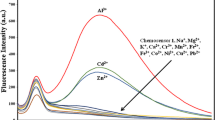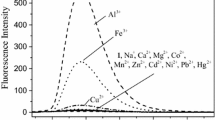Abstract
A new spiropyran-based fluorescent probe was developed for dual detection of Fe2+ ion and pH. Addition of Fe2+ and Ag+ to the probe solution enhanced the fluorescence intensity by 6 and 5 fold, respectively. Addition of Fe3+, Hg2+ and Ni2+ caused slight increase in the fluorescence intensity of the probe. While addition of other common metal ions did not bring about substantial change of the fluorescence. Thus the probe can be used for fluorescence turn-on detection of Fe2+ ion in ethanol/water (9:1) medium. The detection limit of the probe for Fe2+ is 0.77 µM. The suitable pH range for the probe to detect Fe2+ was pH 3 − 9. Other metal ions including Li+, Na+, K+, Ag+, Cu2+, Zn2+, Co2+, Ni2+, Mn2+, Sr2+, Hg2+, Ca2+, Mg2+, Al3+, Cr3+, and Fe3+ did not cause marked interference with Fe2+ recognition. The color of the probe solution was yellow at pH 1 − 2 and colorless at other pH values. The fluorescence intensity of the probe was low at pH 1 − 12 and increased significantly when the pH was 13 and 14, indicating that the probe can be used as a colorimetric and fluorescent probe for sensing extremely acidic or extremely alkaline conditions through different channels.












Similar content being viewed by others
Data Availability
Yes, our manuscript has data included as electronic supplementary material.
Code Availability
Not applicable.
References
Xuan W, Pan R, Wei Y, Cao Y, Li H, Liang F-S, Liu K-J, Wang W (2016) Reaction-based off-on fluorescent probe enabling detection of endogenous labile Fe2+ and imaging of Zn2+-induced Fe2+ flux in living cells and elevated Fe2+ in ischemic stroke. Bioconjugate Chem 27:302–308
Zhu M, Zhao Z, Liu X, Chen P, Fan F, Wu X, Hua R, Wang Y (2021) A novel near-infrared fluorimetric method for point-of-care monitoring of Fe2+ and its application in bioimaging. J Hazard Mater 406:124767
Kouser R, Zehra S, Khan RA, Alsalme A, Arjmand F, Tabassum S (2021) “Turn-On” benzophenone based fluorescence and colorimetric sensor for the selective detection of Fe2+ in aqueous media: validation of sensing mechanism by spectroscopic and computational studies. Spectrochim Acta A 247:119156
Zheng J, Feng S, Gong S, **a Q, Feng G (2020) In vivo imaging of Fe2+ using an easily obtained probe with a large stokes shift and bright strong lipid droplet-targetable near-infrared fluorescence. Sens Actuators B 309:127796
Wu L, Ding Q, Wang X, Li P, Fan N, Zhou Y, Tong L, Zhang W, Zhang W, Tang B (2020) Visualization of dynamic changes in labile Iron(II) pools in endoplasmic reticulum stress-mediated drug-induced liver injury. Anal Chem 92:1245–1251
Guo X, Huang J, Wang M, Wang L (2020) A dual-emission water-soluble g-C3N4@AuNCs-based fluorescent probe for label-free and sensitive analysis of trace amounts of ferrous (II) and copper (II). Ions Sens Actuators B 309:127766
Dong B, Song W, Lu Y, Tian M, Kong X, Mehmood AH, Lin W (2020) Live cell-specific fluorescent probe for the detection of labile Fe(II) and the evaluation of esterase activity in live animals. Sens Actuators B 305:127470
Zhang X, Chen Y, Cai X, Liu C, Jia P, Li Z, Zhu H, Yu Y, Wang K, Li X, Sheng W, Zhu B (2020) A highly sensitive rapid-response fluorescent probe for specifically tracking endogenous labile Fe2+ in living cells and zebrafish. Dyes Pigm 174:108065
Gao G, Wang X, Wang Z, ** X, Ou L, Zhou J, **e P (2020) A simple and effective dansyl acid based “Turn-On” fluorescent probe for detecting labile ferrous iron in physiological saline and live cells. Talanta 215:120908
Wei S, Tan L, Yin X, Wang R, Shan X, Chen Q, Li T, Zhang X, Jiang C, Sun G (2020) A sensitive “ON-OFF” fluorescent probe based on carbon dots for Fe2+. Detect Cell Imaging Anal 145:2357–2366
Huang L, Chen Y, Zhao Y, Wang Y, **ong J, Zhang J, Wu X, Zhou Y (2020) A ratiometric near-infrared naphthalimide-based fluorescent probe with high sensitivity for detecting Fe2+ in vivo. Chin Chem Lett 31:2941–2944
Khatun S, Biswas S, Binov A, Podder A, Mishra N, Bhuniya S (2020) Highly chemoselective turn-on fluorescent probe for ferrous (Fe2+) ion detection in cosmetics and live cells. J Photochem Photobiol B 209:111943
Immanuel David C, Bhuvanesh N, Jayaraj H, Thamilselvan A, Parimala devi D, Abiram A, Prabhu J, Nandhakumarr R (2020) Experimental and theoretical studies on a simple S-S-bridged dimeric schiff base: selective chromo-fluorogenic chemosensor for nanomolar detection of Fe2+ & Al3+ ions and its varied applications. ACS Omega 5:3055–3072
Liu W, Xu O, Li J, Zhu X (2020) Synthesis of poly-amino acid ionic liquid up-conversion fluorescent probe and its application in Fe(II)/Fe(III) speciation analysis. J Fluoresc 30:309–316
Senthikumaran G, Senthil S (2020) Synthesis and characterization of 1,2,3-triazole containing Fe(II) sensor. Asian J Chem 32:1033–1038
Chakraborty S, Joseph MM, Varughese S, Ghosh S, Maiti KK, Samanta A, Ajayaghosh A (2020) A new pentacyclic Pyrylylium fluorescent probe that responds to pH imbalance during apoptosis. Chem Sci 11:12695–12700
Chen Y, Zhao C, Wang Y, Rao H, Lu Z, Lu C, Shan Z, Ren B, Wu W, Wang X (2020) Green and high-yield synthesis of carbon dots for ratiometric fluorescent determination of pH and enzyme reactions. Mater Sci Eng C 117:111264
Kim SY, Podder A, Lee H, Cho Y-J, Han EH, Khatun S, Sessler JL, Hong KS, Bhuniya S (2020) Self-assembled amphiphilic fluorescent probe: detecting pH-fluctuations within cancer cells and tumour tissues. Chem Sci 11:9875–9883
Yuan X, Zhang T, Yan J, Chen X, Wang L, Liu X, Zheng K, Zhang N (2020) A simple acidic ‘Turn-On’ fluorescent probe based on BOPYIN and its visual detection and cellular imaging. Dyes Pigm 177:108318
Nguyen TH, Sun T, Grattan KTV (2020) Novel coumarin-based pH sensitive fluorescent probes for the highly alkaline pH. Region Dyes Pigm 177:108312
Shi X, Yan N, Niu G, Sung SHP, Liu Z, Liu J, Kwok RTK, Lam JWY, Wang W-X, Sung HH-Y, Williams ID, Tang BZ (2020) In vivo monitoring of tissue regeneration using a ratiometric lysosomal AIE probe. Chem Sci 11:3152–3163
Guo Z, Jiao Y, Du F, Gao Y, Lu W, Shuang S, Dong C, Wang Y (2020) Facile synthesis of ratiometric fluorescent carbon dots for pH visual sensing and cellular imaging. Talanta 216:120943
Mendez-Ardoy A, Reina JJ, Montenegro J (2020) Synthesis and supramolecular functional assemblies of ratiometric pH probes. Chem Eur J 26:7516–7536
Liu H, Zhang Y, Zhao Y, Zhao Y, Yang X, Han L, **n J, Yang B, Lin Q (2020) Dual-emission hydrogel nanoparticles with linear and reversible luminescence-response to pH for intracellular fluorescent probes. Talanta 211:120755
Caldwell MA, Brue CR, Whittemore TJ, Meade TJ (2020) A Ln(III)-3-hydroxypyridine pH responsive probe optimized by DFT. RSC Adv 10:8994–8999
Zhang Y, Hou D, Yu X (2020) Facile preparation of FICT-modified silicon nanodots for ratiometric pH. Sens Imaging Spectrochim Acta A 234:118276
Shen W, Wang L, Zhu S, Yu S, Cai C, Yi W, Zhu Q (2020) A dicyanoisophorone-based, near-infrared, lysosome- targeting pH sensor with an extremely large stokes shift. Anal Biochem 596:113609
Diana R, Caruso U, Tuzi A, Panunzi B (2020) A highly water-soluble fluorescent and colorimetric pH. Probe Crystals 10:83
Wu F-h, Luo X-r, Yang J-q, Ren M-j, Wei X-w, Yan Z (2020) A dual-mode colorimetric/fluorescent sensor comprising rhodamine B and piperazine: response to acidic pH values and investigation of recognition mechanism. ChemistrySelect 5:3138–3143
Zhu Z, Zhang Q, Liu P, Zhang J, Cao F (2020) Quasi-simultaneous electrochemical/chemical imaging of local Fe2+ and pH distributions on 316 L stainless steel surface. J Electroanal Chem 871:114107
Kortekaas L, Browne WR (2019) The evolution of spiropyran: fundamentals and progress of an extraordinarily versatile photochrome. Chem Soc Rev 48:3406–3424
Ali AA, Kharbash R, Kim Y (2020) Chemo- and biosensing applications of spiropyran and its derivativesa review. Anal Chim Acta 1110:199–233
Zheng T, Xu Z, Zhao Y, Li H, Jian R, Lu C (2018) Multiresponsive polysiloxane bearing photochromic spirobenzopyran for sensing pH changes and Fe3+ ions and sequential sensing of Ag+ and Hg2+ ions. Sens Actuators B 255:3305–3315
Li H, Zheng T, Zhao Y, Xu Z, Dai X, Shao Z (2018) Multiresponsive polysiloxane bearing spiropyran: synthesis and sensing of pH and metal ions of different valence. Mater Res Express 5:035301
Li Z, Tan Y, Ma Y (1991) Synthesis of N-Benzylindolinospirobenzopyransand spironaphthooxazines. Huaxue Tongbao (in Chinese) (10):41–43
Li Q, Hu Y, Hou H-N, Yang W-N, Hu S-L (2018) A new coumarin-carbonothioate-based turn-on fluorescent chemodosimeter for selective detection of Hg2+. Inorg Chim Acta 471:705–708
Funding
The Funding for the Open Research Program of State Key Laboratory of Molecular Engineering of Polymers, Fudan University (K2020-12 to Hongqi Li) is acknowledged.
Author information
Authors and Affiliations
Contributions
Conceiving and designing of the experiments: Y.S., H.L. and P.C.; Performing research and analyzing the data: D.Z., Y.Q., Y.L. and C.X.; Writing of the paper: D.Z. and H.L. All authors read and approved the final manuscript.
Corresponding authors
Ethics declarations
Competing Interests
The authors declare that they have no known competing financial interests or personal relationships that could have appeared to influence the work reported in this paper.
Additional information
Publisher’s Note
Springer Nature remains neutral with regard to jurisdictional claims in published maps and institutional affiliations.
Supplementary Information
ESM 1
(DOC 264 KB)
Rights and permissions
About this article
Cite this article
Zhang, D., Qi, Y., Li, Y. et al. A New Spiropyran-Based Fluorescent Probe for Dual Sensing of Ferrous Ion and pH. J Fluoresc 31, 1133–1141 (2021). https://doi.org/10.1007/s10895-021-02741-0
Received:
Accepted:
Published:
Issue Date:
DOI: https://doi.org/10.1007/s10895-021-02741-0




